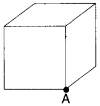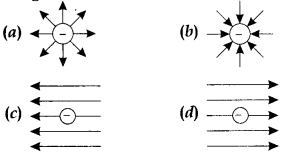Electric Charges and Fields
Class 12th Physics Chapter MCQs
Electric Charges and Fields Class 12 Physics MCQs
1. The surface considered for Gauss’s law is called
(a) Closed surface
(b) Spherical surface
(c) Gaussian surface
(d) Plane surface
Answer
Answer: c
2. The total flux through the faces of the cube with side of length a if a charge q is placed at corner A of the cube is


Answer
Answer: a
3. Which of the following statements is not true about Gauss’s law?
(a) Gauss’s law is true for any closed surface.
(b) The term q on the right side side of Gauss’s law includes the sum of all charges enclosed by the surface.
(c) Gauss’s law is not much useful in calculating electrostatic field when the system has some symmetry.
(d) Gauss’s law is based on the inverse square dependence on distance contained in the coulomb’s law
Answer
Answer: c
4. A charge Q is placed at the centre of the line joining two point charges +q and +q as shown in the figure. The ratio of charges Q and q is
![]()
(a) 4
(b) 1/4
(c) -4
(d) -1/4
Answer
Answer: d
5. The force per unit charge is known as
(a) electric flux
(b) electric field
(c) electric potential
(d) electric current
Answer
Answer: b
6. Electric field lines provide information about
(a) field strength
(b) direction
(c) nature of charge
(d) all of these
Answer
Answer: d
7. Which of the following figures represent the electric field lines due to a single negative charge?

Answer
Answer: b
8. The SI unit of electric flux is
(a) N C-1 m-2
(b) N C m-2
(c) N C-2 m2
(d) N C-1 m2
Answer
Answer: d
9. The unit of electric dipole moment is
(a) newton
(b) coulomb
(c) farad
(d) debye
Answer
Answer: d
10. Consider a region inside which, there are various types of charges but the total charge is zero. At points outside the region
(a) the electric field is necessarily zero.
(b) the electric field is due to the dipole moment of the charge distribution only.
(c) the dominant electric field is inversely pro-portional to r3, for large r (distance from ori-gin).
(d) the work done to move a charged particle along a closed path, away from the region will not be zero.
Answer
Answer: c
11. SI unit of permittivity of free space is
(a) Farad
(b) Weber
(c) C2N-1 m-2
(d) C2N-1 m-2
Answer
Answer: c
12. The attraction is the real proof of an object being charged. Answer: b
(a) True
(b) False
(c) a and b both
(d) None of these
Answer
13. If an object is positively charged, theoretically the mass of the object ______ Answer: b
(a) Increases slightly by a factor of 9.11*10-31 kg
(b) Decreases slightly by a factor of 9.11*10-31 kg
(c) Remains the same
(d) May increase or decrease
Answer
Question 14.
Which one of the following is the unit of electric field?
(a) Coulomb
(b) Newton
(c) Volt
(d) N/C
Answer
Answer: (d) N/C
Question 15.
Three charges + 3q + q and Q are placed on a st. line with
equal separation. In order to maket the net force on q to be zero, the value of
Q will be :
(a) +3q
(b) +2q
(c) -3q
(d) -4q
Answer
Answer: (a) +3q
Question 16.
If an electric dipole is kept in a uniform electric field then
resultant electric force on it is :
(a) always zero
(b) never zero
(c)
depend upon capacity of dipole
(d) None
Answer
Answer: (a) always zero
Question 17.
The number of electron-taken out from a body to produce 1
coulomb of charge will be :
(a) 6.25 × 1018
(b) 625 ×
1018
(c) 6.023 × 1023
(d)
None
Answer
Answer: (a) 6.25 × 1018
Question 18.
The work done in rotating an electric dipole in an electric
field:
(a) W = ME (1 – cos θ)
(b) W = ME tan θ
(c)W = ME sec θ
(d)
None
Answer
Answer: (a) W = ME (1 – cos θ)
Question 19.
If sphere of bad conductor is given charge then it is
distributed on:
(a) surface
(b) inside the surface
(c) only inside the
surface
(d) None
Answer
Answer: (d) None
Question 20.
Electric field in a cavity of metal:
(a) depends upon the
surroundings
(b) depends upon the size of cavity
(c) is always zero
(d)
is not necessarily zero
Answer
Answer: (d) is not necessarily zero
Question 21.
The dielectric constant of a metal is:
(a) 0
(b) 1
(c) ∞
(d) -1
Answer
Answer: (c) ∞
Question 22.
1 coulomb is equal to:
(a) 3 × 109 e.s.u.
(b)
\(\frac{1}{3}\) × 109 e.s.u.
(c) 3 × 1010 e.s.u.
(d)
\(\frac{1}{3}\) × 1010 e.s.u.
Answer
Answer: (a) 3 × 109 e.s.u.
Question 23.
Each of the two point charges are doubled and their distance
is halved. Force of interaction becomes p times, w here p is :
(a) 1
(b)
4
(c) \(\frac{1}{16}\)
(d) 16
Answer
Answer: (d) 16
Question 24.
Coulomb’s law in vector form can be written as
\(\vec{F}
\) = (\(\frac{1}{4πε_n}\)) (\(\frac{q_1q_2}{r^2}\))\(\vec{r} \)
where
ε0 is the permitivity of free space. The SI units of ε0
will be:
(a) N-1m-2C-2
(b)
Nm-2C2
(c)
N-1m-2C9.
(d)
Nm-2C2
Answer
Answer: (c) N-1m-2C9
Question 25.
The dimensional representation of cu will be :
(a)
[MLT4 A2]
(b)
[M-1L-3T4A2]
(c)[ML-2T
]
(d) None of these
Answer
Answer: (b) [M-1L-3T4A2]
Question 26.
When placed in a uniform field, a dipole experiences:
(a)
a net force
(b) a torque
(c) both a net force and torque
(d) neither a
net force nor a torque
Answer
Answer: (b) a torque
Question 27.
A parrot comes and sits on a bare high power line. It
will:
(a) experience a mild shock ‘
(b) experience a strong shock.
(c)
get killed instantaneously
(d) not be affected
practically
Answer
Answer: (d) not be affected practically
Question 28.
The SI units of electric dipole moment are:
(a) C
(b)
Cm-1
(c) Cm
(d) Nm-1
Answer
Answer: (c) Cm
Question 29.
If two conducting sphere are connected after charging
separately then:
(a) Electrostatic energy sphere energy will remain
conserved
(b) Electrostatic energy charges remains conserved
(c)
Electrostatic energy energy and charge remains conserved
(d)
None
Answer
Answer: (b) Electrostatic energy charges remains conserved
Question 30.
A soap bubble is given a negative charge, then its
radius:
(a) increases
(b) decreases
(c) remains unchanged
(d) may
increase or decrease
Answer
Answer: (a) increases
Question 31.
In non-uniform electric field, electric dipole
experiences:
(a) torque only
(b) torque as well as net force
(c) force
only
(d) None of these
Answer
Answer: (b) torque as well as net force
Question 32.
An electron is sent in an electric field of magnitude 9.1 ×
106NC-1. The acceleration produced in it is :
(a) 1.6
ms-2
(b) 1.6 × 1018ms-2
(c) 3.2 ×
1018ms-2
(d) 0.8 × 1018
ms-2
Answer
Answer: (b) 1.6 × 1018ms-2
Question 33.
A semicircular arc of radius r is charged uniformly and the
charge per unit length is λ. The electric field at the centre is:
(a)
\(\frac{λ}{2λε_0r^2}\)
(b) \(\frac{λ}{4πε_0r}\)
(c)
\(\frac{λ^2}{2πε_0r}\)
(d) \(\frac{λ}{2πε_0r}\)
Answer
Answer: (b) \(\frac{λ}{4πε_0r}\)
Question 34.
When a dipole of moment \(\vec{p} \) is placed in uniform
electric field \(\vec{E} \), then the torque acting on the dipole is:
(a)
\(\vec{τ} \) = \(\vec{p} \).\(\vec{E} \)
(b) \(\vec{τ} \) = \(\vec{P} \) +
\(\vec{E} \)
(c) \(\vec{τ} \) = \(\vec{p} \) + \(\vec{E} \)
(d ) \(\vec{τ}
\) = \(\vec{p} \) – \(\vec{E} \)
Answer
Answer: (c) \(\vec{τ} \) = \(\vec{p} \) + \(\vec{E} \)
Question 35.
Two point charges +8q and -2q are located at ,v = O and ,v =
L respectively. The location of a point on the .v-axis at which the net electric
field due to these two point charges b is zero :
(a) 4L
(b) 8L
(c)
L/4
(d) 2L
Answer
Answer: (d) 2L
Question 36.
The graph drawn between V are r for a non-conducting charged
solid sphere of radius R for r < R will be :
(a) straight line
(b)
parabola
(c) hyperbola
(d) None of these
Answer
Answer: (d) None of these
Question 37.
Corona discharge takes place:
(a) at the surface of a
conductor
(b) near the sharp points of a conductor
(c) outside the
conductor
(d) at the centre of the conductor
Answer
Answer: (b) near the sharp points of a conductor
Question 38.
The belt of a Vande Graaf generator gets charge by :
(a)
corona discharge
(b) induction
(c) electrification
(d) None of
these
Answer
Answer: (a) corona discharge
Question 39.
Quantisation of charge implies:
(a) Charge does not
exist
(b) Charge exists on particles
(c) There is a minimum permissible
magnitude of charge
(d) Charge can’t be created
Answer
Answer: (c) There is a minimum permissible magnitude of charge
Question 40.
The conservation of electric charge implies that:
(a)
Charge can’t be created
(b) Charge can’t be destroyed
(c) The number of
charged particle in the universe is constant
(d) Simultaneous creation of
equal and opposite charges is permissible
Answer
Answer: (d) Simultaneous creation of equal and opposite charges is permissible
Question 41.
The number of electrons contained in one coulomb of charge
is:
(a) 6.25 × 1018
(b) 6.25 × 1017
(c) 6.25 ×
1019
(d) 1.6 × 1019
Answer
Answer: (a) 6.25 × 1018
Question 42.
The unit of intensity of electric field is :
(a)
metre/volt
(b) Joule/newton
(c) Coulomb/newton
(d)
Newton/coulomb
Answer
Answer: (a) metre/volt
Question 43.
1 V equals to:
(a) 1 J
(b) 1 JC-1
(c) 1
CJ-1
(d) 1 JC
Answer
Answer: (b) 1 JC-1
Question 44.
1 V m-1 equals to:
(a) 1 N
(b) 1
Mm-1
(c) 1 NC-1
(d) 1
J-1
Answer
Answer: (c) 1 NC-1
Question 45.
The minimum amount of charge observed so far is:
(a) 1
C
(b) 4.8 × 1-13 C
(c) 1.6 × 10-19 C
(d) 1.6 ×
1019 C
Answer
Answer: (c) 1.6 × 10-19 C
Question 46.
The ratio of electric force between two electrons to the
gravitational force between them is of the order:
(a) 1042
(b)
1039
(c) 1036
(d) 1
Answer
Answer: (a) 1042